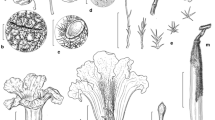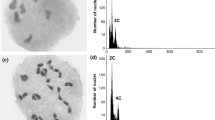Abstract
As in most taxa that contain gametophytic apomicts, all of the apomictic biotypes studied so far in the genus Hieracium subgenus Pilosella have been recorded as polyploids. As part of a study of variation in apomictically derived populations of H. aurantiacum, a diploid plant was identified. Apospory, the mechanism of apomixis typically observed in this taxon, was observed in this plant. Unreduced megagametophytes at various developmental stages were commonly observed in the developing ovules, and endosperm formation was autonomous. The eventual seed set, however, was low. This appears to have been due to the proliferation of competing megagametophytes and embryos within each ovule. Pollen sterility was also observed, primarily resulting from the dysfunction of microgametogenesis at the uninucleate stage.
Similar content being viewed by others
Author information
Authors and Affiliations
Additional information
Received: 3 September 1996 / Revision accepted: 21 March 1997
Rights and permissions
About this article
Cite this article
Bicknell, R. Isolation of a diploid, apomictic plant of Hieracium aurantiacum . Sex Plant Reprod 10, 168–172 (1997). https://doi.org/10.1007/s004970050084
Issue Date:
DOI: https://doi.org/10.1007/s004970050084




